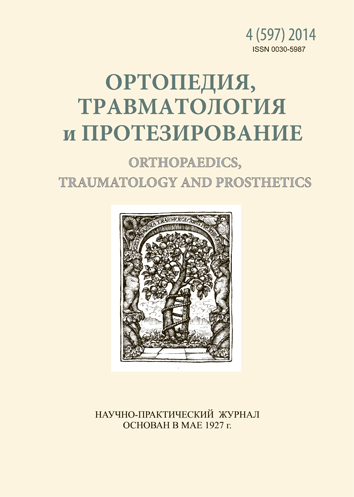Clonogenic activity of bone marrow stromal stem cells in various forms of course of idiopathic and dysplastic coxarthrosis
DOI:
https://doi.org/10.15674/0030-59872014436-40Keywords:
idiopathic and dysplastic coxarthrosis, clonogenic activity, stromal stem cells from bone marrow, course patternAbstract
Objective: To determine clonogenic activity of bone marrow stromal stem cells (BMSSC) in bones forming the hip joint in patients with various forms of course of idiopathic and dysplastic coxarthrosis (CA). Methods: We cloned BMSSC according to A. J. Friedenstein method. A total of 56 patients with idiopathic and 23 dysplastic CA stage IV were examined. We studied 201 bone marrow samples (140 — idiopathic and 61 — dysplastic CA), 325 cultures of BMSSC were grown. Cancellous bone was taken from three sites: the roof of the acetabulum, femoral head and intertrochanteric area. Course of CA was determined according to the working classification developed. We used also statistical methods. Results: It was found that the higher the course rate of idiopathic or dysplastic CA the lower clonogenic activity of BMSSC in bones forming the hip joint. It was revealed that the state of the connective tissue influences directly to the development of violations in trophic processes in bone tissue of patients with a form of rapid course of CA which is confirmed by the results of X-ray (atrophic type of bone formation according to Bombelli), biochemical (decreasing of content of glycosaminoglycans and protein synthesizing fraction of hydroxyproline in serum) and other studies. Conclusions: There was an inverse relationship between the clonogenic activity of BMSSC in bones forming the hip joint, and the speed (and consequently form) of course for idiopathic and dysplastic CA. There was proved significant (p ≤ 0,05) decreasing in osteogenic potency of BMSSC in patients with a form of rapid course of CA. Revealed features bring closer to understanding the complex of pathogenic mechanisms of idiopathic and dysplastic CA, prove an important role of connective tissue dysplasia in it and provide a differentiated approach to the methods of surgical treatment (use of bone autoplasty, etc.).
References
- Batra S. Rapidly destructive osteoarthritis of the hip joint: a case series / S. Batra, М. Batra, A. McMurtrie // J. Orthop. Surg. Res. — 2008. — Vol. 3 (3). — P. 1749–1799. DOI: 10.1186/1749-799X-3-3.
- Bombelli R. Osteoarthritis of the hip. Pathogenesis and consequent therapy / R. Bombelli. — Berlin-Heidelberg-New York: Springer, 1976. — P. 27–28.
- Kellgren J. Radiological assessment of osteoarthritis / J. Kellgren, J. Lawrence // Ann. Rheum. Dis. — 1957. — Vol. 16. — P. 494–501.
- Spector T. D. How serious is knee osteoarthritis? / T. D. Spector, D. J. Hart // Ann. Rheum. Dis. — 1992. — Vol. 51 (10). — Р. 1105–1106.
- Weinstein D. F. The bone and joint decade / S. L. Weinstein // J. Bone Joint Surg. — 2000. — Vol. 82-A, № 1. — P. 237–266.
Downloads
How to Cite
Issue
Section
License
Copyright (c) 2014 Georgy Gaiko, Lesya Panchenko, Olexiy Kalashnikov

This work is licensed under a Creative Commons Attribution 4.0 International License.
The authors retain the right of authorship of their manuscript and pass the journal the right of the first publication of this article, which automatically become available from the date of publication under the terms of Creative Commons Attribution License, which allows others to freely distribute the published manuscript with mandatory linking to authors of the original research and the first publication of this one in this journal.
Authors have the right to enter into a separate supplemental agreement on the additional non-exclusive distribution of manuscript in the form in which it was published by the journal (i.e. to put work in electronic storage of an institution or publish as a part of the book) while maintaining the reference to the first publication of the manuscript in this journal.
The editorial policy of the journal allows authors and encourages manuscript accommodation online (i.e. in storage of an institution or on the personal websites) as before submission of the manuscript to the editorial office, and during its editorial processing because it contributes to productive scientific discussion and positively affects the efficiency and dynamics of the published manuscript citation (see The Effect of Open Access).














